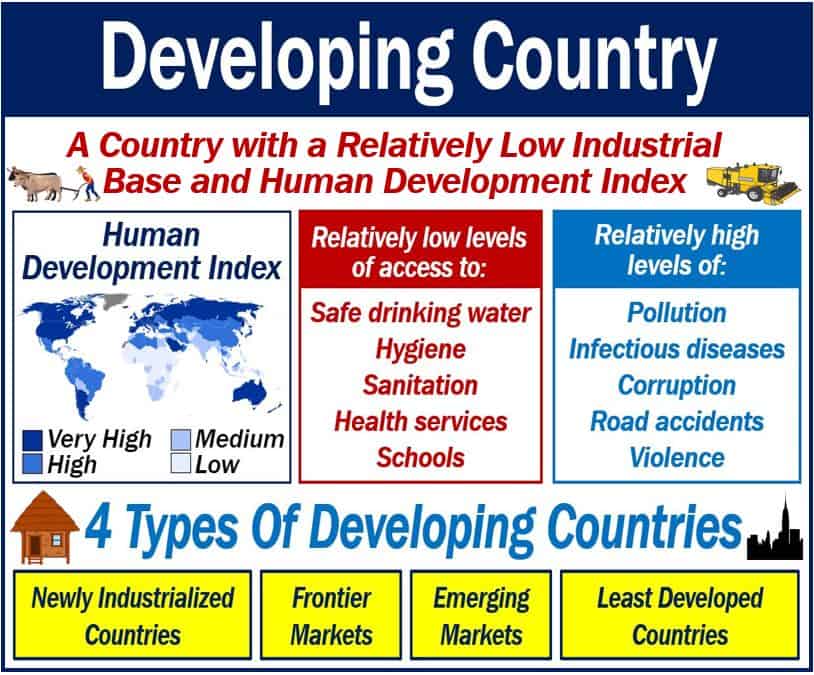A Developing Country is a nation that fares poorly on the HDI and has low levels of industrialization. HDI stands for Human Development Index. A developing country is less developed than a developed country. We also refer to developed countries as advanced economies.
A developing country is a relatively poor agricultural country that is trying to become more advanced economically. It is also seeking to become more advanced socially.
Incorporating sustainable agricultural practices is becoming a cornerstone for developing countries, aiming to balance economic growth with environmental stewardship.
The World Trade Organization (WTO) says that the majority of its membership consists of developing countries. The WTO is a global organization that deals with the rules and regulations of trade between countries.

Developing country – a ‘tricky’ term
The World Bank describes the terms ‘developing world’ and ‘developing country’ as ‘tricky.’ The World Bank is a UN institution that offers loans to developing countries for capital projects.
Using the terms is tricky even when people use them cautiously and are not judging the country’s development status.
When listing or categorizing countries for statistics and reports, the World Bank does not use the term ‘developing country.’
According to the World Bank:
“The World Bank has for many years referred to ‘low and middle-income countries’ as ‘developing countries’ for convenience in publications, but even if this definition was reasonable in the past, it’s worth asking if it has remained so and if a more granular definition is warranted.”
The IMF, in the World Economic Outlook, used the terms advanced economies, emerging markets, and developing economies. IMF stands for International Monetary Fund.
Developing country – many interpretations
How do we define the term developing country? Some people say that it refers to a nation with a less developed industrial base. Others say it also has a relatively low Human Development Index.
GDP per capita also contributes to the definition. GDP per capita is a population’s GDP per head. To get the per capita figure, we divide GDP by the country’s total population. GDP stands for gross domestic product.
GDP per capita tells us how wealthy one nation’s people are in comparison to those of other nations.
We instinctively know what it means
Even though people might disagree on the precise definition of ‘developing country,’ we all interpret it similarly.
For example, imagine you select ten people at random and ask them to look at the names four countries. The countries are Switzerland, Norway, Somalia, and Cambodia. If you then ask them which are developing countries and which are advanced economies, what will they probably say?
It is likely that everybody will say that Somalia and Cambodia are developing countries. Norway and Switzerland, on the other hand, are advanced economies, they will also say.
If you give them the names of forty countries, they will probably agree on how they classified most of them.
‘Developing country’ means the same thing to most people
Therefore, even though experts disagree on its precise definition, most people understand what it means. Most people’s interpretation of the term ‘developing country’ is fairly similar.
The term ‘developing’ refers to a currently observed situation. In other words, it does not refer to an expected direction of progress or changing dynamic.
For the past twenty years, a developing country typically has had a higher growth rate than an advanced economy.
According to Wikipedia, there are four types of developing countries. Their classification depends on their economic size or capital market growth. Below is a list of the four types plus a brief description of each one.
1. Newly industrialized countries
Newly industrialized countries have not yet reached the status of an advanced economy. However, they have, in a macroeconomic sense, pulled ahead of their developing counterparts.
This term emerged in the 1970s when Taiwan, South Korea, Singapore, and Hong Kong rose to global prominence. We referred to those four countries as the Asian Tigers.
2. Emerging markets
Emerging markets have some characteristics of developed markets. However, they have not yet met a developed market’s standards. We also use the term ‘emerging economies.’
The world’s largest emerging markets today are those of China and India. The Economist says that many people find this term outdated. However, it points out that no new term has taken its place.
3. Frontier markets
A frontier market nation is a developing country that is more developed than the least developing nations. However, its economy is too small for us to call it an ’emerging’ market.’
We use this term for the less accessible and smaller, but still ‘investable,’ developing nations.
4. Least developed countries
According to the United Nations, the least developed countries or LDCs exhibit the lowest indicators of socioeconomic development. They also have the world’s lowest Human Development Index ratings.
Many people and organizations feel uncomfortable using the term ‘developing country,’ and have adopted other terms. They feel that the term may imply there is a judgment on the part of the speaker or writer.
Global partnerships are increasingly pivotal in bolstering the economies of developing countries, and fostering sustainable development through technology transfer and shared expertise.
Technological advancements, particularly in digital infrastructure, are proving to be a catalyst for economic growth in developing countries, enabling better access to global markets and resources.
